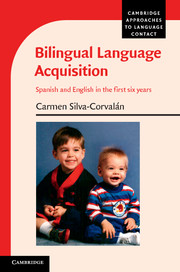Book contents
- Frontmatter
- Dedication
- Contents
- List of figures
- List of tables
- Series editor’s foreword
- Preface
- Acknowledgments
- List of abbreviations
- 1 Introduction
- 2 Methodology
- 3 Bilingual development
- 4 Subjects in English and Spanish
- 5 The order of constituents: subject position in English and Spanish
- 6 The acquisition of ser, estar, and be
- 7 The development of verb morphology
- 8 Discussion and conclusions
- Appendix 1 Transcription instructions
- Appendix 2 Calculation of MLUw
- Appendix 3 Spanish adjectives used with copulas up to age 6;0
- Appendix 4 The siblings’ early verb lexicon in English and Spanish
- Appendix 5 Excerpt from an adapted Goldilocks story
- References
- Index of authors
- General index
5 - The order of constituents: subject position in English and Spanish
Published online by Cambridge University Press: 18 December 2014
- Frontmatter
- Dedication
- Contents
- List of figures
- List of tables
- Series editor’s foreword
- Preface
- Acknowledgments
- List of abbreviations
- 1 Introduction
- 2 Methodology
- 3 Bilingual development
- 4 Subjects in English and Spanish
- 5 The order of constituents: subject position in English and Spanish
- 6 The acquisition of ser, estar, and be
- 7 The development of verb morphology
- 8 Discussion and conclusions
- Appendix 1 Transcription instructions
- Appendix 2 Calculation of MLUw
- Appendix 3 Spanish adjectives used with copulas up to age 6;0
- Appendix 4 The siblings’ early verb lexicon in English and Spanish
- Appendix 5 Excerpt from an adapted Goldilocks story
- References
- Index of authors
- General index
Summary
Introduction
The position of the subject with respect to the verb has attracted much less attention from scholars of monolingual and bilingual acquisition than the position of the object and the verb. Research on word order involving the alternation subject verb object (SVO) versus subject object verb (SOV) is abundant (De Houwer 1990 and Meisel 1986 are pioneer studies of this issue). By contrast, research on the position of the subject in bilingual first language acquisition is almost non-existent as far as I know, even though this grammatical aspect differs in many language pairs, as it does in English and Spanish. Indeed, subject position challenges the language comprehension and production skills of the English-Spanish developing bilingual.
Similarly to the issue of subject realization, the position of the subject in English declarative sentences presents only one option: preverbal; while in Spanish there are two options with respect to the verb: preverbal and postverbal position. Thus, the study of the placement of subjects by bilinguals in a basically fixed SVO-order language, English, and a language with flexible word order, Spanish, allows us to examine hypotheses about crosslinguistic interaction and about what makes a language vulnerable to influence from another language. This is related to the overall goal of the book, which is to find out the effect that different degrees of exposure to and use of English and Spanish have on some aspects of two siblings’ emerging grammars.
- Type
- Chapter
- Information
- Bilingual Language AcquisitionSpanish and English in the First Six Years, pp. 170 - 218Publisher: Cambridge University PressPrint publication year: 2014



